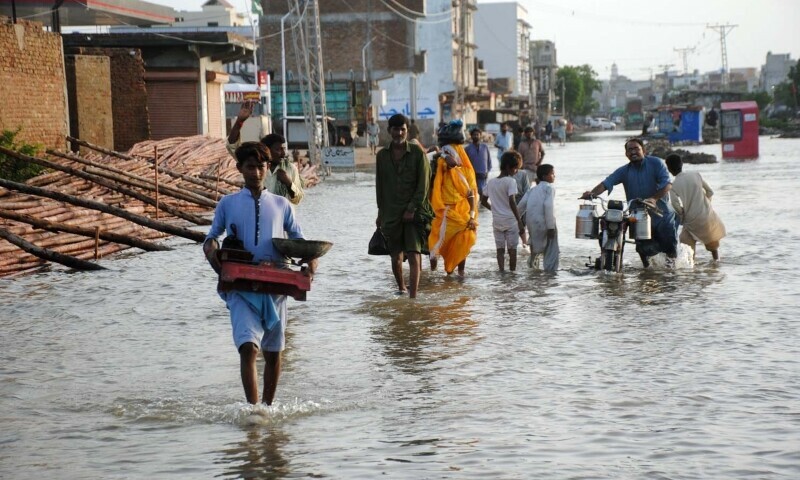The back-to-back spells of heavy rains in Sindh have displaced 1.67 million people in the province’s lower and upper regions, according to a report released by the Provincial Disaster Management Authority (PDMA) on Friday.
Assessing the situation from June 20 to August 25, the report said that a total population of 4.9m and 648,621 households have been affected.
The report said the death toll for Sindh has gone up to 339 in rain and flood-related incidents. Among those deaths, 117 were males, 46 females and 108 were children, while 974 people were injured.
The PDMA report stated that 98,260 cattle had perished so far while 191,030 houses were fully damaged and 395,080 partially damaged. Additionally, 2.72m acres of crop area had been rendered unusable.

The PDMA said that the NDMA was also providing help to the PDMA with 3,880 ration bags, 3,600 mosquito nets, 4900 plastic tarpaulin, 4,835 tents and 95 dewatering pumps.
Meanwhile, the post-rain situation still remained critical for residents as dewatering work in rain-affected areas remained slow.
Areas in Qasimabad taluka, Latifabad Units-2, 8, 11 and 12 were badly hit by rainwater which was fixed with sewage now. “The disposal is being delayed as the system is not carrying the required quantum of downpour runoff from the areas”, said Javed Malik, a resident from worst-hit unit 12 of Latifabad.
Among the displaced persons, a majority is of peasants — also known as sharecroppers. They had shifted to roadsides of farmlands after their mud houses caved in or entire villages were flooded.

Most of those displaced have found shelter in improvised tents — some of which were provided by the government as well as non-governmental organisations. “For food supplies, we are dependent on charity given by well-off people”, said Ramo, a resident in Jhuddo tehsil of Mipurkhas.
Other parts of Mipurkhas were disturbed as well due to the slow disposal through the Left Bank Outfall Drain (LBOD), which had a discharge of 10,000 cusecs against the designed discharge of 4,000 cusecs.
“Once levels of inflow start receding in the drain, it will carry more rainfall runoff from other areas”, said Mansoor Memon, director of Sukkur barrage’s Nara Canal.
The tehsil was hit by the LBOD that was filled to capacity as far as its discharge is concerned.
“For me, it is flowing miraculously and we hope that no breach occurs in the spinal [main] drain of the LBOD, which can prove to be catastrophic otherwise”, said Farid Memon, the LBOD’s project director. He said breaches in sub-drains of the system did occur but luckily the spinal/main drain was still saved although a few breaches occurred in the 2020 rains.

The LBOD takes rainwater to creeks of the Arabian Sea. It was bifurcated into Kadhan Pateji Outfall Drain (KPOD) and Dhoro Puran Outfall Drain (DPO) at RD-159 in Badin district. People of Badin consider LBOD a ghost which has always spelt disaster for their district in every monsoon or natural calamity due to its faulty design.
“It is a monster and the government should not invest in LBOD further. Government should close or abandon it”, a local journalist Rashid Leghari had said while putting a question to the chief minister regarding the LBOD last week at a press briefing.
Meanwhile, the Indus river remains in high flood at Sukkur barrage and medium at Guddu barrage, according to a report issued today by the Flood Forecasting Division (FFD). The FFD reported a discharge of 490,393 cusecs of flows up and downstream while the Sukkur barrage was having a high flood discharge of 569,756 cusecs up and downstream. A flow of 500,000 cusecs plus is rated as a high flood.
The Kotri barrage reported a medium flood discharge of 35,279 cusecs up and downstream at 6am on August 27.
Meanwhile, 14 off-taking canals of all three barrages have been closed for around a fortnight due to anticipated rains and flooding in the Indus River.
According to the FFD report, the Tarbela dam would attain its maximum storage soon. Its storage stood at 1549.5ft at noon on Aug 27, according to figures available from the Sindh irrigation department.
Torrential rains wreak havoc in Sanghar
The torrential rains during the current monsoon spells wreaked havoc across the board in district Sanghar.
The extraordinary spells of rainfall have made life difficult across all six taluka of the district: Khipro, Sanghar, Jam Nawaz Ali, Sinjhoro, Shahdad Pur and Tando Adam.

Massive displacement of both the human population and livestock has been witnessed. The breaches in saline drains have also added to the people’s suffering and caused their move to elevated areas under the open skies and to government schools, colleges and nearby cities.
The farmers have also lost their livelihoods as their crops have been completely destroyed.
Charity organisations and some local individuals have initiated local food drives, while the Benazir Income Support Programme stipend amounting to Rs25,000 was also being distributed among its registered beneficiaries.
According to data shared by the Sanghar district administration, as of Friday, the houses damaged in the current rains stood at 52,498, while the number of affected population and families was estimated to be at 598,380 and 89,441 respectively.
The displaced population was calculated to be 321,555 while 89 per cent of the crop area was damaged.
Additionally, 12 deaths and 14 injuries were reported, along with 135 livestock animals killed.
According to the data available, 35,000 people were living in relief camps set up by the provincial government.













































